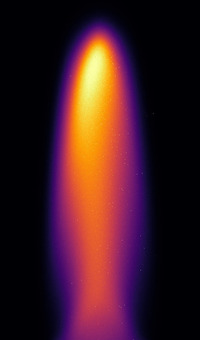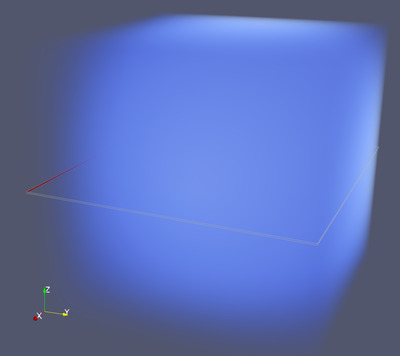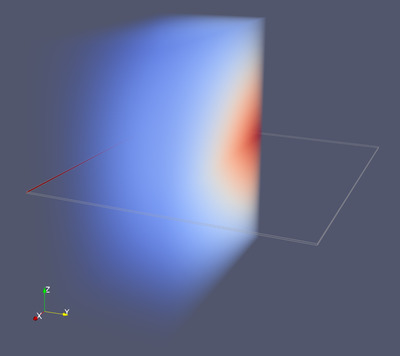htrdr: Combustion Starter-Pack
This archive contains datasets for performing calculations with the
htrdr-combustion
program. Shell scripts are also provided that run htrdr-combustion on this
data, without frills. Their only refinement is that command-line arguments are
defined using variables for easy reading. In fact, these scripts are examples
that are good starting points for studying how to run htrdr-combustion.
Users are encouraged to edit and extend them.
To run scripts, assuming htrdr-combustion is installed and registered in the
current shell, one can simply execute the desired script to run calculations.
Computed images can be converted into regular PPM images which can then be
displayed with a normal image viewer. For instance, for the Gülder test case:
sh htrdr-Combustion-Starter-Pack-0.1.0/gulder/draw_gulder.sh
htpp -vm range=0,0.02 -o gulder.ppm gulder_image_240x360x256.txt
Downloads
| Version | Archive |
|---|---|
| 0.1.0 | [tarball] [pgp] |
Gulder
The gulder directory contains the dataset for the open diffusion flame of the
well-known Gülder test case: physical properties of the participating medium
are provided without any solid boundary. The following quantities have been
provided over a unstructured volumic grid by the
AVBP solver: molar fraction of H₂O, CO and
CO₂, size and number density of primary soot particles, as well as the total
soot volumic fraction.
For the wavelength of interest (532 nm), the gas mixture is considered as perfectly transparent, and the only radiatively active species is the soot. Its radiative properties (absorption and scattering cross-sections, and phase functions) are computed at runtime, according to the RDG-FA
Provided files are:
tetra_mesh.smsh: it stores the tetrahedral mesh which represents the Gülder flame (~7 millions of tetrahedra).refraction_index.atrri: this file defines the spectrally varying refractive index of the medium.thermodynamic_conditions.atrtp: it records the physical properties per node of the tetrahedral mesh.
Finally, we provide the draw_gulder.sh script that renders an image of the
flame, seen from a height approximately equal in the middle of the flame, and at
a distance of 120 mm. The flame is illuminated by a laser sheet, 1 mm thick,
which cuts the flame vertically by its central axis. The vertical plane of the
laser sheet is perpendicular to the normal of the camera. It is a fictional
experimental setup used to show what the flame looks like.
Rendering in the visible range of the Gülder flame calculated by htrdr-combustion. The flame is illuminated by a vertical laser sheet that crosses the central axis of the flame, from left to right. The image displays the radiation emitted by the laser, scattered and transmitted by the combustion medium for wavelength (here 532 nm).
Dummy medium
The dummy_medium directory contains the data that describe a dummy combustion
medium in the general case of an heterogeneous medium enlighten by a laser
sheet. It is an axis aligned cube of 0.2 m side length. The (x=0, y=0) position
is the center of the bottom face of the cube, meaning that x and y coordinates
vary in the [-0.1, 0.1] m range, while the z coordinate varies in the
[0, 0.2] m range.
The laser sheet is 1 mm thick, is horizontal, and splits the medium at half height: the altitude of the laser sheet therefore varies in the [0.0995, 0.105] m range, while x and y coordinates vary in the [-0.1, 0.1] m range. The laser sheet is emitted from the y=0 plane, and propagates in the direction of positive y. Its wavelength is 532 nm, and its surface power density is 1000 W/m².
The sensor on which the flux will be computed is located in the center of the bottom limit of the combustion medium. It is a square of 5 cm side length: x and y coordinates over the sensor vary in the [-0.025, 0.025] m range, and z=0.
Boundaries of the combustion chamber are black, and the sensor is also a blackbody: whenever radiation reaches a boundary, it is fully absorbed. Only the flux that reaches the sensor is accounted for.
Soot aggregates absorb and scatter radiation within the limits of the combustion chamber. Their optical cross-sections are computed according to the RDG-FA theory, using the following data:
- refraction index: 1.60+0.75.i
- fractal dimension: 1.80
- fractal prefactor: 1.30
- primary particles diameter: 20 nm
- number of primary particles per aggregate: 100
The soot volume fraction follows the following inhomogeneous axisymmetric profile:
fv(x,y,z)=fv_max*(1/2-x/L)*(1-sqrt(2*((y/L-1/2)²+(z/L-1/2)²)))
with fv_max the maximum soot volumic fraction, reached at x=-L/2, y=0, z=L/2,
L the length of the cubic combustion chamber, x and y in [-L/2, L/2] and z in
[0, L]. fv_max is set at 10^-6 m³ of soot per m³.
Provided files are:
tetra_mesh.smsh: it stores the tetrahedral mesh which represents the heterogeneous medium (12 millions of tetrahedra).refraction_index.atrri: this file defines the spectrally varying refractive index of the medium.thermodynamic_conditions.atrtp: it records the physical properties per node of the tetrahedral mesh.
Two shell scripts are also available:
compute_flux_density_map.sh: it calculates a flux density map on the dummy medium. Its output can then be compared to that returned by the validation program (see below).draw_image.sh: it renders an image of the medium.
Illustration of the dummy medium provided in the Starter Pack. This medium is illuminated by a laser sheet whose surface of emission is here represented in red.
Dummy medium clipped along the y axis to emphasize the axisymmetric profile of its soot volume fraction.
Validation program
The sw_flux directory contains a simple program, written in Fortran, that was
designed to solve the problem of interest only (fixed geometric configuration
and analytical thermodynamic properties fields). However, two separate
Monte-Carlo algorithms have been implemented in order to compute the required
flux:
- a direct Monte-Carlo algorithm: optical trajectories are followed from the laser emission surface, until they reach the sensor (or are lost).
- a reverse Monte-Carlo algorithm: this is actually the one that was
implemented into
htrdr-combustion. Optical paths start from the sensor, and a first-scattering contribution increases the weight of the realization at each scattering position in the medium.
To compile the executable simply invoke make into the sw_flux directory.
Note that the build procedure assumes that the GNU Fortran compiler
(gfortran) is installed. Once built, run the generated executable named
sw_flux. Both algorithms (direct and reverse) must agree, within the limits
of the statistical uncertainty. Furthermore, these results should also agree
with the flux computed by htrdr-combustion via the script
dummy_medium/compute_flux_density_map.sh.
~ $ cd htrdr-Combustion-Starter-Pack-0.1.0/sw_flux
sw_flux $ make
sw_flux $ ./sw_flux
sw_flux $ cd ../dummy_medium/
dummy_medium $ ./compute_flux_density_map.sh
The result should be, in terms of surface power density:
1.028e-2 +/- 1e-5 W/m²
Release notes
Version 0.1
- Add the Gülder dataset.
- Make the dummy dataset compliant with
htrdr0.9: converts the volumetric mesh from the Star-Tetrahedra file format to the Star-Mesh file format.
Copyright notice
Copyright © 2021, 2023 |Méso|Star> (contact@meso-star.com)
Copyright © 2021 Centre National de la Recherche Scientifique
License
htrdr: Combustion Starter Pack is released under the GPLv3+ license: GNU GPL
version 3 or later. You can freely study, modify or extend it. You are also
welcome to redistribute it under certain conditions; refer to the
license for details.



